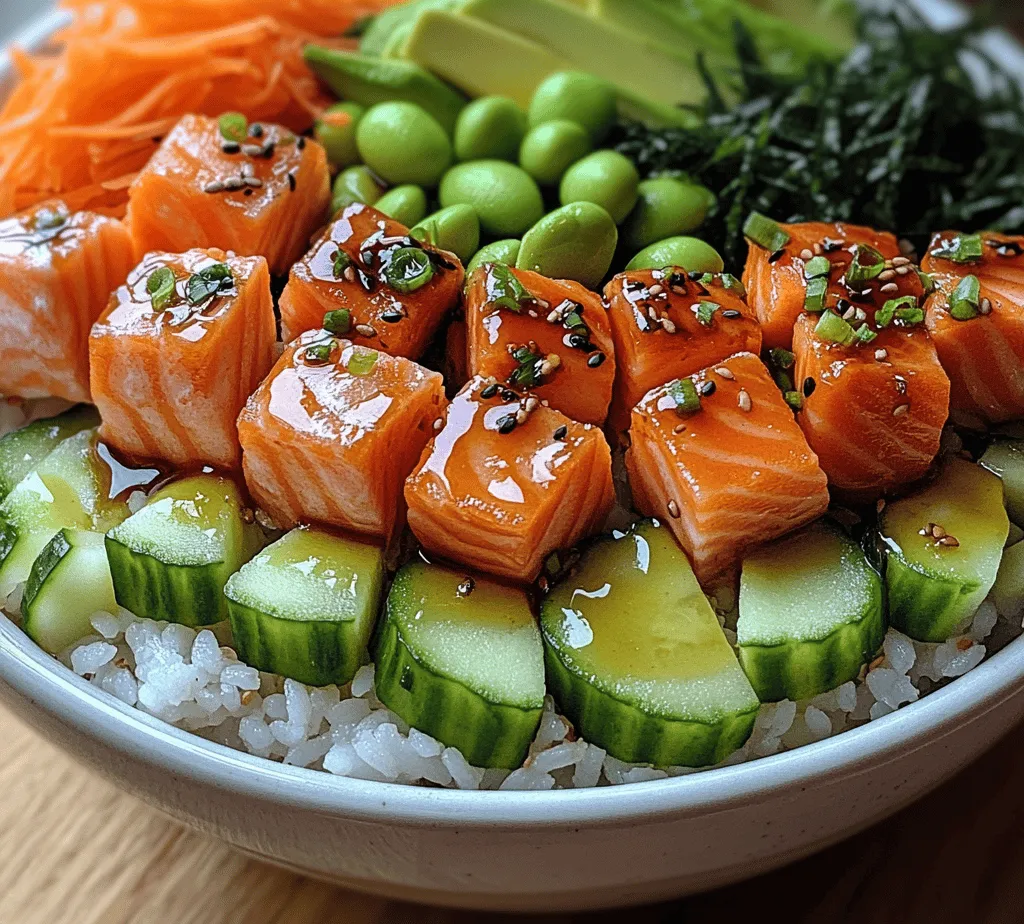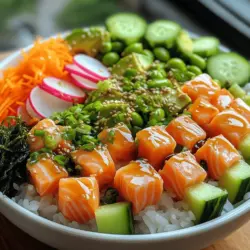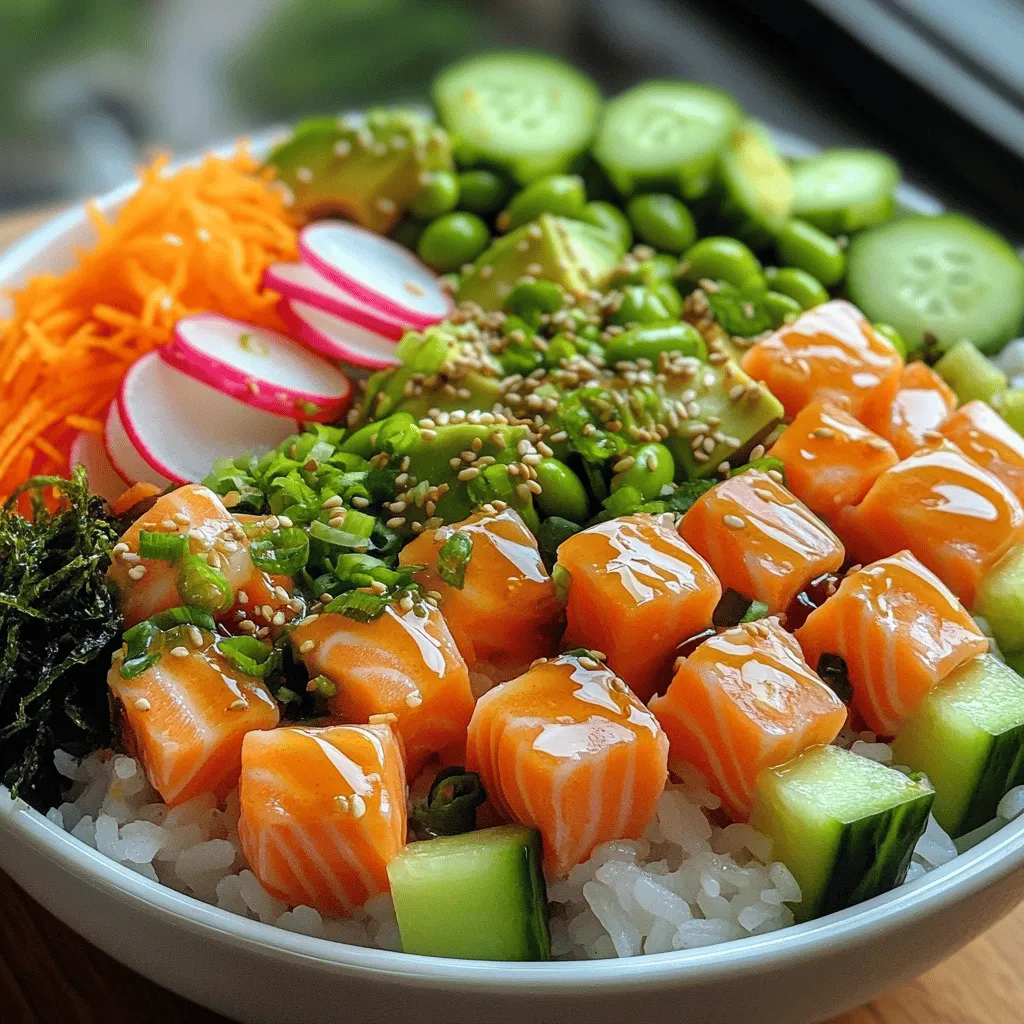Sushi has become a global sensation, appreciated not just for its unique flavors but also for its artful presentation. Originating from Japan, this traditional dish has evolved over the years, gaining a dedicated following worldwide. Sushi encompasses a variety of styles, from nigiri to maki, each with its own distinct characteristics and flavor profiles. However, the rising trend of deconstructed dishes offers a fresh perspective on how we enjoy our favorite foods, making the concept of deconstructed sushi bowls increasingly popular among home cooks and food enthusiasts alike.
What Are Deconstructed Sushi Bowls?
Deconstructed sushi bowls take the classic elements of sushi and present them in a more accessible format. Rather than rolling fish and vegetables in rice and seaweed, these bowls allow for customization and flexibility, catering to various dietary preferences. Whether you are a vegetarian, gluten-free eater, or simply someone who enjoys experimenting with flavors, deconstructed sushi bowls offer the perfect platform to create a meal that fits your needs. This dish allows you to mix and match ingredients, ensuring everyone’s preferences are met without compromising on taste.
One of the most appealing aspects of deconstructed sushi bowls is the vibrant array of fresh ingredients they feature. From colorful vegetables to high-quality proteins, the emphasis on freshness brings out the natural flavors of each component. The combination of textures—from creamy avocado to crunchy cucumber—creates a delightful dining experience that is as visually appealing as it is delicious.
The Importance of Fresh Ingredients
When it comes to sushi, the quality of ingredients is paramount. Freshness directly impacts the taste and overall enjoyment of the dish. For deconstructed sushi bowls, sourcing the best components is essential. Opting for locally-sourced vegetables, sushi-grade fish, or organic tofu can elevate your bowl to new heights. The vibrant colors and textures of fresh ingredients not only enhance the visual appeal of the dish but also contribute to the overall flavor profile.
Understanding Sushi Rice
At the heart of any sushi dish lies the rice, specifically sushi rice, which is short-grain rice known for its sticky texture. Sushi rice is essential for holding the dish together and should be prepared with care to achieve the right consistency and flavor.
What Is Sushi Rice?
Sushi rice, also known as shari or sumeshi, is characterized by its short, plump grains. This type of rice absorbs water easily and becomes sticky when cooked, allowing it to hold its shape when molded or rolled. The texture is critical for achieving that authentic sushi experience, whether you’re forming nigiri or simply serving it in a bowl.
The Significance of Rinsing Sushi Rice
Before cooking, rinsing sushi rice is a crucial step that many home cooks overlook. Rinsing removes excess starch that can cause the rice to become overly gummy and clump together. By washing the rice under cold water until the water runs clear, you ensure that the grains remain separate and achieve the desired texture.
Step-by-Step Explanation of Cooking Sushi Rice
1. Measure the Rice: Start by measuring out the desired amount of sushi rice. A common serving size is 1 cup of uncooked rice, which yields about 2-3 servings when cooked.
2. Rinse the Rice: Place the rice in a fine-mesh strainer or a bowl. Rinse it under cold water, gently swirling the rice with your hand to help release the starch. Repeat this process until the water runs clear.
3. Soak the Rice: Allow the rinsed rice to soak in fresh water for about 30 minutes. This step helps the grains absorb moisture, resulting in a more even cooking process.
4. Cook the Rice: Drain the soaked rice and transfer it to a rice cooker or pot. For every cup of rice, add 1 1/4 cups of water. If using a rice cooker, simply follow the manufacturer’s instructions. If cooking on the stovetop, bring the mixture to a boil, reduce the heat to low, cover, and cook for about 15-20 minutes or until all the water is absorbed.
5. Let It Rest: Once the rice is cooked, turn off the heat and let it sit, covered, for an additional 10 minutes. This resting period allows the rice to steam and firm up slightly.
Importance of Seasoning Sushi Rice
To transform plain rice into sushi rice, seasoning is necessary. After cooking, the rice should be mixed with a combination of rice vinegar, sugar, and salt to achieve the signature flavor associated with sushi. Here’s how to do it:
1. Prepare the Seasoning: In a small bowl, combine 1/4 cup of rice vinegar, 2 tablespoons of sugar, and 1 teaspoon of salt. Stir until the sugar and salt are dissolved.
2. Season the Rice: Transfer the warm rice to a large bowl or a wooden sushi tub (hangiri). Gradually pour the vinegar mixture over the rice while gently folding it with a spatula or rice paddle. Be careful not to mash the grains; the goal is to coat them evenly with the seasoning.
3. Cool the Rice: Allow the seasoned rice to cool to room temperature before serving. This cooling process helps to set the flavors and texture.
With perfectly cooked and seasoned sushi rice as the foundation, the next step in crafting your deconstructed sushi bowl is to explore an array of delicious toppings that will complement the rice and create a well-rounded meal.
Exploring the Toppings for Deconstructed Sushi Bowls
The beauty of deconstructed sushi bowls lies in their versatility. The toppings you choose can reflect your personal preferences or dietary needs, making this dish an excellent option for a variety of eaters. Below are some traditional sushi toppings along with their roles in creating a balanced and flavorful bowl.
Avocado
Avocado is a staple ingredient in many sushi dishes, known for its creamy texture and healthy fats. It adds richness to the bowl and pairs beautifully with both fish and vegetables. Slice the avocado into thin wedges or cubes, and arrange them artfully over the rice.
Cucumber
Cucumber brings a crisp freshness to the bowl, providing a refreshing contrast to the other ingredients. Its mild flavor makes it a versatile choice that complements a wide range of toppings. Thinly slice the cucumber or cut it into julienne strips for added visual appeal.
Carrot
Carrots add a touch of sweetness and crunch to your deconstructed sushi bowl. Grating or spiralizing the carrots can enhance their texture and make them easier to eat. Their vibrant orange color also contributes to the overall aesthetic of the dish.
Edamame
Edamame is a nutrient-packed protein source that is both delicious and satisfying. These young soybeans can be found in the pod or shelled, and they add a pop of green to the bowl. Lightly steaming or boiling the edamame enhances their flavor and texture.
Radishes
Radishes offer a peppery bite and a burst of color, making them an excellent addition to your sushi bowl. Slice them thinly or use a mandoline for even, delicate rounds. Their refreshing crunch balances the richness of other ingredients.
Sushi-Grade Fish
For those who enjoy raw fish, sushi-grade fish is a must-have topping. Options like tuna, salmon, or yellowtail not only provide rich flavors but also essential nutrients like omega-3 fatty acids. When sourcing sushi-grade fish, it’s important to buy from a reputable fishmonger to ensure quality and safety.
Tofu as a Vegetarian Substitute
Tofu is an excellent alternative for vegetarians or anyone looking to reduce their meat consumption. It is a versatile protein source that can be marinated and grilled, adding depth to your sushi bowl. Choose firm or extra-firm tofu for the best texture, and consider marinating it in soy sauce or a sesame sauce for added flavor.
The Role of Garnishes
Garnishes like seaweed strips and pickled ginger play a crucial role in enhancing the overall dish. Seaweed strips add a savory umami flavor and a satisfying crunch, while pickled ginger provides a refreshing contrast that cleanses the palate between bites.
Crafting the Soy Sauce Drizzle
No sushi bowl is complete without a drizzle of soy sauce or a flavorful dressing. The sauce elevates the dish, tying all the elements together and enhancing their individual flavors. A simple soy sauce drizzle can be made by mixing soy sauce with a touch of sesame oil, lime juice, or even a hint of sriracha for those who like a bit of heat.
In summary, deconstructed sushi bowls not only celebrate the rich flavors of traditional sushi but also provide an opportunity for creativity and customization. By focusing on fresh ingredients, well-prepared sushi rice, and a variety of toppings, you can create a vibrant and satisfying meal that caters to a wide range of dietary preferences. The next sections will explore the assembly of these bowls and offer tips for achieving the best results, ensuring your deconstructed sushi bowl is a hit every time.

Breakdown of Ingredients in the Soy Sauce Drizzle
The soy sauce drizzle is a crucial component of your deconstructed sushi bowl, providing a flavorful finishing touch that ties all the ingredients together. Here’s a breakdown of each ingredient in the drizzle and its role in enhancing your dish:
– Soy Sauce: As the primary flavor base, soy sauce brings that quintessential umami taste that is synonymous with sushi. When choosing soy sauce, consider low-sodium options to control salt intake, or gluten-free varieties made from tamari for those with dietary restrictions. The type of soy sauce can subtly affect the flavor profile; for a more complex taste, you might opt for dark soy sauce, while light soy sauce is milder and less intense.
– Sesame Oil: Known for its nutty flavor, sesame oil adds depth to the drizzle. It’s also rich in antioxidants and healthy fats, making it a nutritious addition. A little goes a long way, so use it sparingly to enhance the overall flavor without overpowering the other ingredients.
– Honey or Agave Syrup: To balance the saltiness of the soy sauce, a touch of sweetness from honey or agave syrup is essential. This ingredient creates harmony in the drizzle, making it not only savory but also subtly sweet. Honey provides additional health benefits, including antibacterial properties, while agave syrup is a vegan alternative that offers a similar sweetness.
– Sriracha: For those who enjoy a little heat, adding Sriracha elevates the drizzle with a spicy kick. This versatile condiment can be adjusted to taste, allowing you to cater to different spice preferences. For a milder option, consider using less or even substituting with a dash of red pepper flakes.
– Variations of the Drizzle for Different Taste Preferences: Experimenting with the drizzle can customize your deconstructed sushi bowls further. For a citrusy twist, add a splash of lime juice or yuzu to the mix. For a sweeter profile, consider incorporating a bit of maple syrup. Alternatively, a sprinkle of sesame seeds can add texture and a nutty finish.
Assembling Your Deconstructed Sushi Bowls
Creating visually appealing deconstructed sushi bowls is not only about taste but also presentation. Follow this step-by-step guide to assemble your bowls beautifully:
1. Base Layer: Start with your choice of base, which could be sushi rice, cauliflower rice, or even quinoa. Spread this evenly across the bottom of your bowl for a solid foundation.
2. Protein Placement: Next, add your protein source. Arrange slices of fresh fish, tofu, or chicken in a circular pattern or in neat rows for a clean look. This not only enhances visual appeal but also makes it easy for diners to identify the protein.
3. Vegetable Arrangement: Choose a variety of colorful vegetables such as sliced cucumbers, shredded carrots, and edamame. Place these in sections around the protein, ensuring that the colors contrast and complement each other. The array of textures and hues makes the bowl inviting and appetizing.
4. Avocado Slices: If using avocado, fan out the slices beautifully over the top of the bowl. Avocado adds creaminess and richness, which balances the other ingredients.
5. Garnishing: Finish with a sprinkle of sesame seeds, chopped green onions, or nori strips for an added crunch and flavor. These garnishes also serve as decorative elements that enhance the overall presentation.
6. Drizzle Time: Finally, drizzle your prepared soy sauce mixture over the assembled bowl. You may want to use a small squeeze bottle or a spoon to control the amount and ensure an even distribution across the ingredients.
Tips on Arranging Toppings for the Best Presentation
– Color Contrast: Aim for a rainbow of colors in your bowl. The vibrant hues of fresh vegetables not only make the dish visually appealing but also promise a variety of nutrients.
– Height Variation: Create visual interest by layering some ingredients. For instance, pile the edamame or shredded carrots higher than the rice to give the bowl depth.
– Use of Shapes: Consider the shapes of your ingredients; round slices of cucumber and triangular slices of avocado can create a playful contrast.
– Balance: Ensure that each component is proportionate and balanced. Avoid overcrowding one side of the bowl, which can detract from the overall aesthetic.
Suggestions for Serving Styles: Individual Bowls vs. Communal Platters
When it comes to serving your delicious deconstructed sushi bowls, you have two main options:
– Individual Bowls: This is ideal for a more personalized dining experience. Each guest receives their own bowl, allowing them to enjoy a customized meal. This style is perfect for gatherings where guests may have different dietary preferences or restrictions.
– Communal Platters: For a more social dining experience, consider presenting the ingredients on a large platter. Allow guests to build their own bowls, choosing their preferred ingredients. This not only fosters interaction but also encourages creativity and customization.
Nutritional Benefits of Deconstructed Sushi Bowls
Deconstructed sushi bowls are not only delicious but also packed with nutritional benefits:
– Overview of Health Benefits from Each Ingredient: Each component in your deconstructed sushi bowl contributes to a well-rounded meal. The fish provides high-quality protein and omega-3 fatty acids; vegetables add fiber, vitamins, and antioxidants; and healthy fats from ingredients like avocado and sesame oil promote heart health.
– Balanced Meal Components: A well-constructed bowl includes carbohydrates, proteins, and healthy fats, creating a balanced meal that keeps you satisfied. Sushi rice or quinoa provides the necessary carbohydrates, while fish or tofu delivers protein, and avocado contributes healthy fats.
– Benefits of Incorporating Fresh Vegetables: Fresh vegetables are essential for adding nutrients to your diet. They are low in calories and high in vitamins, minerals, and antioxidants, promoting overall health and wellness. Including a variety of colors ensures a broad spectrum of nutrients.
– Comparison to Traditional Sushi Rolls: Compared to traditional sushi rolls, deconstructed sushi bowls can often be lower in calories and carbohydrates, especially if you substitute rice with vegetables or grains. Additionally, the customizable nature of the bowls allows for healthier choices and portion control.
Cultural Significance of Sushi and Its Modern Interpretations
Understanding the cultural significance of sushi deepens our appreciation for dishes like deconstructed sushi bowls:
– Brief History of Sushi and Its Evolution: Sushi originated in Japan as a method of preserving fish in fermented rice. Over time, it evolved into various forms, such as nigiri and maki rolls, becoming a beloved cuisine worldwide. Today, sushi has been adapted and reinterpreted in countless ways, reflecting local ingredients and tastes.
– The Rise of Deconstructed Dishes in Contemporary Cuisine: In recent years, the trend of deconstructing traditional dishes has gained popularity. Chefs and home cooks alike enjoy the creativity and flexibility that deconstructed dishes offer, allowing for personal expression and innovation while still honoring the essence of the original cuisine.
– How Deconstructed Sushi Reflects Modern Cooking Trends: Deconstructed sushi bowls are emblematic of a shift towards healthier eating and customization in modern cooking. They cater to diverse dietary preferences and encourage the use of fresh, whole ingredients, aligning with contemporary culinary trends focused on nutrition and sustainability.
Conclusion
Deconstructed sushi bowls are a versatile and appealing way to enjoy the flavors of sushi without the intricate rolling process. Their customizable nature allows for endless experimentation with flavors and textures, making them suitable for various dietary needs and preferences. By embracing creativity in the kitchen, you can create a dish that is not only visually stunning but also packed with nutrients.
Whether you choose to serve individual bowls or set up a communal platter, deconstructed sushi bowls are sure to impress your family and friends. Encourage them to join in on the fun of assembling their own bowls, making mealtime a delightful experience. So, gather your ingredients, unleash your culinary creativity, and enjoy the fresh, homemade taste of these sushi-inspired bowls at home.

